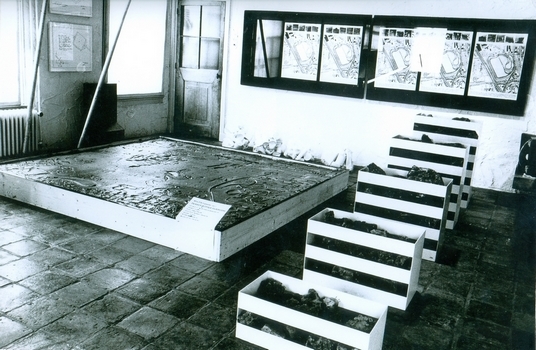In December 2010, the Peanut Butter Floor (1962) by Wim T. Schippers was acquired for the collection of Museum Boijmans Van Beuningen. From this spring, the floor will be on display in an exhibition that will also include other collection works by the artist, such as the floating stone 'Het Is Me Wat' (1999) and the white carpet 'Eggs' (1966), made of mops and green eggs. Covering a floor with peanut butter is an example of the conceptual working method of the artist, who with his art wants to show that in principle everything is meaningless and nonsensical, but therefore worthwhile. Museum Boijmans Van Beuningen is delighted with the purchase and the exhibition. Sjarel Ex: "This is one of the most important purchases of 2010".
Interactive
Wim T. Schippers' peanut butter installation is a work of art that can be installed in various ways. For instance, the floor sculpture in Museum Boijmans Van Beuningen will not be completely square, as was the case in the past. The Pindakaasvloer consists of a kind of frame in which a certain amount of peanut butter is placed in the desired thickness. The exhibition includes a video with interviews by Wim T. Schippers and art collector Harry Ruhé. The video examines the origins and significance of the work of art. The film also shows how the floor came into being. This video will be shown in the exhibition hall and on the ArtTube video channel. Because the Peanutbutterfloor does not leave the visitors unmoved and raises questions, they can record a video with a question for Wim T. Schippers. He will answer a selection of these questions by webcam.
Endive and spinach
The Pindakaasvloer has a long history. The concept of the floor was conceived over 40 years ago and first performed at Galerie Mickery in Loenersloot. Later, the Centraal Museum in Utrecht also exhibited the floor during the retrospective of Schippers in 1997. The Pindakaasvloer originated in a certain context and is part of an entire oeuvre of floor sculptures by the artist. Schippers started his floor sculptures in 1962 in Museum Fodor. Here, he sprinkled one room entirely with salt, while another room was filled with broken pieces of window glass. This is where the idea for the Pindkaasvloer originated. At a later exhibition in Galerie Amstel '47 (Amsterdam), Schippers once again worked with things on the floor, and for an exhibition in Galerie '20 by Felix Valk (later Galerie Jaki Kornblitt), he had thought up a floor of cooked spinach. The gallery owner did not like the idea, so the artist suggested endive.
In trouble
Wim T. Schippers is a television maker, radio maker, writer and visual artist. His voice is famous as the voice of Ernie in Sesame Street and of programmes from the 1960s and 1970s such as Hoepla, Fred Haché and Sjef van Oekel. As an artist, Schippers is known in the Netherlands for his much-discussed conceptual works, such as the sculpture of the floating stone 'Het Is Me Wat' (1999); a colossal lump of stone-like material that floats above a pedestal by means of three large electromagnets. The artwork was on loan in 2010 for the World Expo in Shanghai, but is now back in Museum Boijmans Van Beuningen. In the attitude to life of Wim T. Schippers, the central theme is that life has no point. This philosophy has caused controversy several times in his work.
